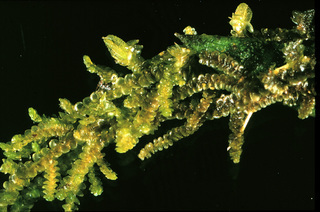Bryophyta of the Cape Horn ArchipelagoWilliam R BuckNew York Botanical Gardens bbuck@nybg.org Bernard Goffinet University of Connecticut goffinet@uconn.edu John J Engel The Field Museum, Chicago jengel@fieldmusuem.org Matt von Konrat The Field Museum, Chicago mvonkonrat@fieldmusuem.org John Pickering University of Georgia, Athens |
 Frullania pycnantha Liverwort |
| Discover Life | All Living Things | Plantae | Bryophyta | Top |
|
Overview
Collaborative Research on the Bryophytes of the Cape Horn Archipelago:
Floristics, Phylogeography and Implications for Biodiversity
Conservation: Bryophytes are critical components of many terrestrial
ecosystems yet they often are understudied,
especially in southern Chile. There are immense gaps in our knowledge
regarding bryophyte
taxonomy and biogeography in the south temperate zone of South America.
This project seeks to complete a comprehensive treatment of the bryophytes
(mosses,
hepatics, anthocerotes) of Provincia Antártica Chilena, a physically and
biogeographically distinct
region of Chile known to be a center of biological richness and south
temperate endemism for
nonvascular cryptogams and diverse animal groups. Because of its biological
diversity, the Cape Horn
Archipelago is the subject of increasing conservation interest and
activity. Organizations such as the
Fundación Omora, in conjunction with UNESCO, are working to design and
implement strategies
aimed at sustainable conservation of the region's unique biodiversity. In
order to efficiently and
effectively accomplish this goal, accurate and detailed information for all
groups of organisms is
needed. Bryophytes were initially investigated because the local indigenous
people of the region, the
Yahgan (= Yamana), identified bryophytes and lichens as more diverse than
vascular plants, and their
observations have been verified by our field work. To date we have found
numerous species new to
the region, including disjuncts from the Northern Hemisphere and species
previously thought to be
Antarctic/subantarctic endemics. Several new species have already been
definitely identified from our
previous collections, and there are many tentative new species requiring
additional study. The project
is led by two taxonomists (Buck who has worked for the last four years in
southern Chile on mosses
and Engel who has spent his entire career working on south temperate and subantarctic hepatics) and
a systematist (Goffinet) who will refine estimates of biodiversity by
testing for the presence of
endemic cryptic species. With combined bryological field experience of over
70 years, political and
logistical support provided by authorities, institutions and organizations,
including the prior funding
of this project by multiple agencies, now is the critical time to carry out
this project. The field work
accomplished by the PIs, as well as the strong political and logistical
support provided by the Chilean
government and agencies, have created an opportunity to complete the
inventory. The economic
threats on the landscape define the urgency of providing a comprehensive
treatment of the
bryophytes, which represent the most diverse component of the flora of the
Cape Horn region.
Intellectual merit. Building on completed initial work, we will produce a comprehensive account of the diversity, taxonomy, and distribution of the region's bryoflora that will have major implications in understanding the phylogeny of these groups and will shed new light on the origins of the south temperate biota. This will result in several products: 1) the first large scale set of bryophyte specimens from the region and the most important ones made there in well over 100 years, including a set to be deposited at the Universidad de Magallanes; 2) publications of new moss, hepatic and anthocerote species; 3) a book that will make accessible for the first time information on all the bryophytes of the Cape Horn region; 4) a multifaceted web site providing keys and illustrations; 5) a phylogeographic analysis of critical disjunct taxa; and 6) a searchable, GIS-linked database of the major holdings of Cape Horn bryophyte collections housed at NY, F, CONN and H, along with other linked information. Broader impacts. The results of the proposed work will increase the awareness of this diverse component of the vegetation of the Cape Horn Archipelago and be directly relevant to ongoing conservation planning and implementation by multiple agencies and organizations, including the use of bryophytes for determining conservation priorities. It will provide educational opportunities for American and Chilean students in bryology. Most importantly it will help build the infrastructure at the Universidad de Magallanes in order for it to become a center for Chilean cryptogamy. |
| Discover Life | All Living Things | Identification Guides | Plantae | Bryophyta | Top |